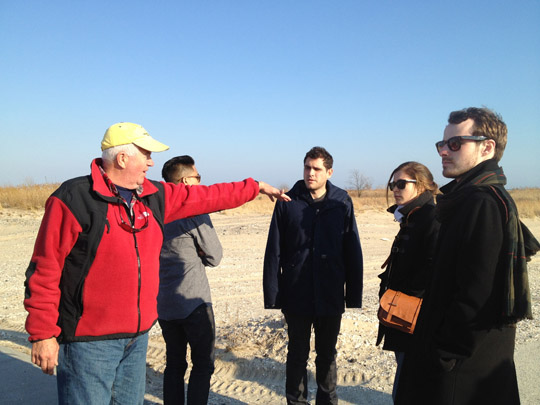Students of the Disaster Field Lab: Creating Resilient Cities proved their mettle Monday, May 13, as they showcased projects with practical implications for intervention and future planning in the communities affected by Superstorm Sandy. Attended by a jury that included Loeb Fellows, GSD faculty, disaster experts and community representatives, they displayed the innovation, creativity, social awareness and problem-solving abilities for which the GSD is famous.
Interest among students was so high that enrollment was twice the expected number. Despite the large class, students created initiatives that, while complementary, were entirely distinct and covered a wide range of interests, from redesign of public housing to increase safety and storm resistance to a digital app that archives lessons from past disasters. The presentations were in seven natural groupings: Policy and Funding, Architecture, Infrastructure, Mapping/Wayfinding, Social Support, Shelters and Ecology.
In the Policy and Funding group Victor Negrete (MUP ’13) looked at managed retreat in Fox Beach, while Elise Baudon (MUP I) followed the federal disaster relief money. David Ginsberg (MUP I) examined the feasibility of vertical buyouts in the vulnerable west side of Hoboken, where he will continue to work with the city after graduation to refine his data, identify funding and determine the validity of a buyout program. Students conducted an impressive amount of research for their projects, and they exposed as many questions as they answered given the complexity of the challenges.
Jurors applauded the students’ concepts and detail, while taking the opportunity to raise important practical and philosophical issues. Tessa Huxley (LF ‘87), director of the Battery Park City Parks Conservancy, questioned the impact of vertical buyouts on streetscape and walkability and whether relief funding in the form of SBA loans – rather than grants – could really help vulnerable small businesses. Jerold Kayden (professor of urban planning and design) raised the critical long range issue of how to change expectations that the government will always be there to bail people out, an objective that buyouts may undercut.
Alison Ledwith (MArch), part of the Architecture group, demonstrated how public housing in Red Hook East can be designed or retrofitted to enable residents to shelter in place in severe storm conditions. While appreciating the comprehensiveness and creativity of her solution, Charles McKinney (LF ’94), principal urban designer with NYC Parks department, looked at a larger societal question: whether it is right to place so many vulnerable people in such an easily impacted area.
During lunch, youth from the Rockaway Waterfront Alliance’s urban studies program screened a documentary they had made of their community and experiences, with the mentoring of professional filmmakers. The GSD students’ close work with the communities was also reflected in the remarks of jury member Frances Medina, executive coordinator of the Red Hook Initiative: “Other groups toured around to see what happened and left. The GSD students came in wanting to learn about the community and how they could improve things for the neighborhoods. They asked our opinion about the needs and changes. I was able to tell my story and they put it into their projects. Being here today has taught me things I can take back to the community.”
McKinney summed up the feelings of many on the jury. “I have never participated in a review, either professional or academic, that addressed such a range of disaster issues. The students prepared focused problem and solution statements and clear concept illustrations, often backed up with calculations. There was sufficient detail to convince me that the solutions were on target. The Disaster Field Lab proved that design is a powerful problem solving profession capable of addressing social issues, and it demonstrated the power of designers as leaders.”
Photos (from top): Tom Fox (LF ’89) with students at Breezy Point, Walter Meyer discusses coastal ecology on the Rockaways beach, Frances Medina and studio participants in front of the Red Hook Initiative, Brooklyn
